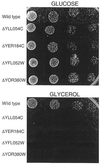Phenotypic analysis of genes encoding yeast zinc cluster proteins
- PMID: 11353088
- PMCID: PMC55459
- DOI: 10.1093/nar/29.10.2181
Phenotypic analysis of genes encoding yeast zinc cluster proteins
Abstract
Zinc cluster proteins (or binuclear cluster proteins) possess zinc fingers of the Zn(II)2Cys6-type involved in DNA recognition as exemplified by the well-characterized protein Gal4p. These fungal proteins are transcriptional regulators of genes involved in a wide variety of cellular processes including metabolism of compounds such as amino acids and sugars, as well as control of meiosis, multi-drug resistance etc. The yeast (Saccharomyces cerevisiae) sequencing project has allowed the identification of additional zinc cluster proteins for a total of 54. However, the role of many of these putative zinc cluster proteins is unknown. We have performed phenotypic analysis of 33 genes encoding (putative) zinc cluster proteins. Only two members of the GAL4 family are essential genes. Our results show that deletion of eight different zinc cluster genes impairs growth on non-fermentable carbon sources. The same strains are also hypersensitive to the antifungal calcofluor white suggesting a role for these genes in cell wall integrity. In addition, one of these strains (YFL052W) is also heat sensitive on rich (but not minimal) plates. Thus, deletion of YFL052W results in sensitivity to a combination of low osmolarity and high temperature. In addition, six strains are hypersensitive to caffeine, an inhibitor of the MAP kinase pathway and phosphodiesterase of the cAMP pathway. In conclusion, our analysis assigns phenotypes to a number of genes and provides a basis to better understand the role of these transcriptional regulators.
Figures



Similar articles
-
Phenotypic analysis of a family of transcriptional regulators, the zinc cluster proteins, in the human fungal pathogen Candida glabrata.G3 (Bethesda). 2014 Mar 21;4(5):931-40. doi: 10.1534/g3.113.010199. G3 (Bethesda). 2014. PMID: 24657903 Free PMC article.
-
New regulators of drug sensitivity in the family of yeast zinc cluster proteins.J Biol Chem. 2002 Jun 14;277(24):21254-60. doi: 10.1074/jbc.M202566200. Epub 2002 Apr 9. J Biol Chem. 2002. PMID: 11943786
-
A fungal family of transcriptional regulators: the zinc cluster proteins.Microbiol Mol Biol Rev. 2006 Sep;70(3):583-604. doi: 10.1128/MMBR.00015-06. Microbiol Mol Biol Rev. 2006. PMID: 16959962 Free PMC article. Review.
-
Comparative genetic and physiological studies of the MAP kinase Mpk1p from Kluyveromyces lactis and Saccharomyces cerevisiae.J Mol Biol. 2000 Jul 21;300(4):743-58. doi: 10.1006/jmbi.2000.3916. J Mol Biol. 2000. PMID: 10891267
-
Evolution of a fungal regulatory gene family: the Zn(II)2Cys6 binuclear cluster DNA binding motif.Fungal Genet Biol. 1997 Jun;21(3):388-405. doi: 10.1006/fgbi.1997.0993. Fungal Genet Biol. 1997. PMID: 9290251 Review.
Cited by
-
CTA4 transcription factor mediates induction of nitrosative stress response in Candida albicans.Eukaryot Cell. 2008 Feb;7(2):268-78. doi: 10.1128/EC.00240-07. Epub 2007 Dec 14. Eukaryot Cell. 2008. PMID: 18083829 Free PMC article.
-
Identification of InuR, a new Zn(II)2Cys6 transcriptional activator involved in the regulation of inulinolytic genes in Aspergillus niger.Mol Genet Genomics. 2008 Jan;279(1):11-26. doi: 10.1007/s00438-007-0290-5. Epub 2007 Oct 5. Mol Genet Genomics. 2008. PMID: 17917744 Free PMC article.
-
Function and regulation of the Saccharomyces cerevisiae ENA sodium ATPase system.Eukaryot Cell. 2007 Dec;6(12):2175-83. doi: 10.1128/EC.00337-07. Epub 2007 Oct 19. Eukaryot Cell. 2007. PMID: 17951516 Free PMC article. No abstract available.
-
Life-span extension by pigmented rice bran in the model yeast Saccharomyces cerevisiae.Sci Rep. 2019 Dec 2;9(1):18061. doi: 10.1038/s41598-019-54448-9. Sci Rep. 2019. PMID: 31792269 Free PMC article.
-
Role of Candida albicans transcription factor Upc2p in drug resistance and sterol metabolism.Eukaryot Cell. 2004 Dec;3(6):1391-7. doi: 10.1128/EC.3.6.1391-1397.2004. Eukaryot Cell. 2004. PMID: 15590814 Free PMC article.
References
-
- Todd R.B. and Andrianopoulos,A. (1997) Evolution of a fungal regulatory gene family: the Zn(II)2Cys6 binuclear cluster DNA binding motif. Fungal Genet. Biol ., 21, 388–405. - PubMed
-
- Lohr D., Venkov,P. and Zlatanova,J. (1995) Transcriptional regulation in the yeast GAL gene family: a complex genetic network. FASEB J., 9, 777–787. - PubMed
-
- Pfeifer K., Kim,K.S., Kogan,S. and Guarente,L. (1989) Functional dissection and sequence of yeast HAP1 activator. Cell, 56, 291–301. - PubMed
-
- Creusot F., Verdiere,J., Gaisne,M. and Slonimski,P.P. (1988) CYP1 (HAP1) regulator of oxygen-dependent gene expression in yeast. I. Overall organization of the protein sequence displays several novel structural domains. J. Mol. Biol., 204, 263–276. - PubMed
Publication types
MeSH terms
Substances
LinkOut - more resources
Full Text Sources
Molecular Biology Databases

